Nîmes is said to be the most Roman city outside Italy. In fact, the city’s rich history dates back to the Roman Empire. It still boasts amazing antique monuments such as the Amphitheater of Nîmes and the so-called Maison Carrée.
Yet, on the outskirts of the historic center, you also find some truly remarkable urban art. In addition, you absolutely need to try some of Nîmes’ culinary gems like Brandade, a popular cod gratin, and my personal favorite, the Pâté Nîmois, stuffed puff pastry.
Do you want a glass of regional wine with it?
You know what, let me just quickly put into writing for you what absolutely not to miss when in Nîmes, even if you’re in town for just one day.

The Most Roman City of France
The city of Nîmes has so much fascinating history that it’s actually hard to understand why it isn’t a bigger tourist magnet. Yes, the city has two prominent highlights nearby: Arles, world-famous thanks to Vincent van Gogh’s paintings, and the former papal residence of Avignon. But that shouldn’t stop you from visiting this hidden gem, especially since the two supposed competitors are only half an hour away.

Nîmes was founded around 500 BC, and Emperor Augustus made it the regional capital. This gave the city not only one of the longest defensive walls in the Roman world. In addition, with the Pont du Gard, the city got a 30-mile-long aqueduct to supply water to the growing population. Today, the aqueduct, which is about 25 kilometers northeast of the city, is listed as a UNESCO World Heritage Site.
However, the core of Roman Nîmes was a temple called the Maison Carrée. This temple competes with the Pantheon in Rome as the most complete and magnificent surviving structure of the Roman Empire.
When in Rome Nîmes…
While Nîmes is primarily known for its Roman sights, the city also offers a lot of other beautiful things. There is a pretty, traffic-calmed old town with picturesque streets lined with elegant houses and many idyllic squares.

In the warm sunshine of Provence, a walk through the Jardin de la Fontaine is wonderfully relaxing. The sprawling, elegant park consists of an elaborate network of canals and paths and is full of Baroque sculptures. The garden was completed just 50 years after Versailles was built. Its peculiarity is that it was one of the first large gardens created not for a king, but for the common people.
Jeans – the Most Un-American Clothing
But don’t think that the Canal de la Fontaine was built so you could walk along it. It was originally used to operate mills and soak wool, silk, and cotton during the process of textile production.
At the end of the 17th century, textile production made Nîmes the leading French city for hosiery, woolen fabrics, and shawls. Those were exported throughout Europe and far beyond.

Jeans – a US export hit? Ha, that’s what you think! The USA is a master at appropriating cultural goods from all over the world and passing them off as its national treasures. This is also the case with jeans, probably the most un-Amarican piece of clothing.
It was in the center of Nîmes where the industrialist Joseph André traded in silk and serge, twill in English. Twill from Nîmes, hence, in French Serge de Nîmes.
De Nîmes. Denim.
Hence, it was the French who first produced this robust material. They sought to recreate Jeane, a durable cotton corduroy made in the Italian city of Genoa in the 16th century.
Jeane. Jeans.
In 1847, the widow Rebecca Strauss migrated from a small German town to the USA with her three youngest children. Together with two little girls, there was also Löb, a little boy who, in his new home, changed his name to the simpler Levi.
Levi Strauss.
This is where the strands of the story come together. After Levi Strauss initially traded in haberdashery and fabrics, he soon began making durable work trousers using this solid blue fabric from Nîmes, enhancing the seams with rivets.
The rest is history. A very European history.
City of Art and History
Nîmes calls itself the city of art and history. But I’m not sure whether the city fathers have the kind of art in mind for which I came to Nîmes in the first place. If you know my blog, then you know my enthusiasm for street art.
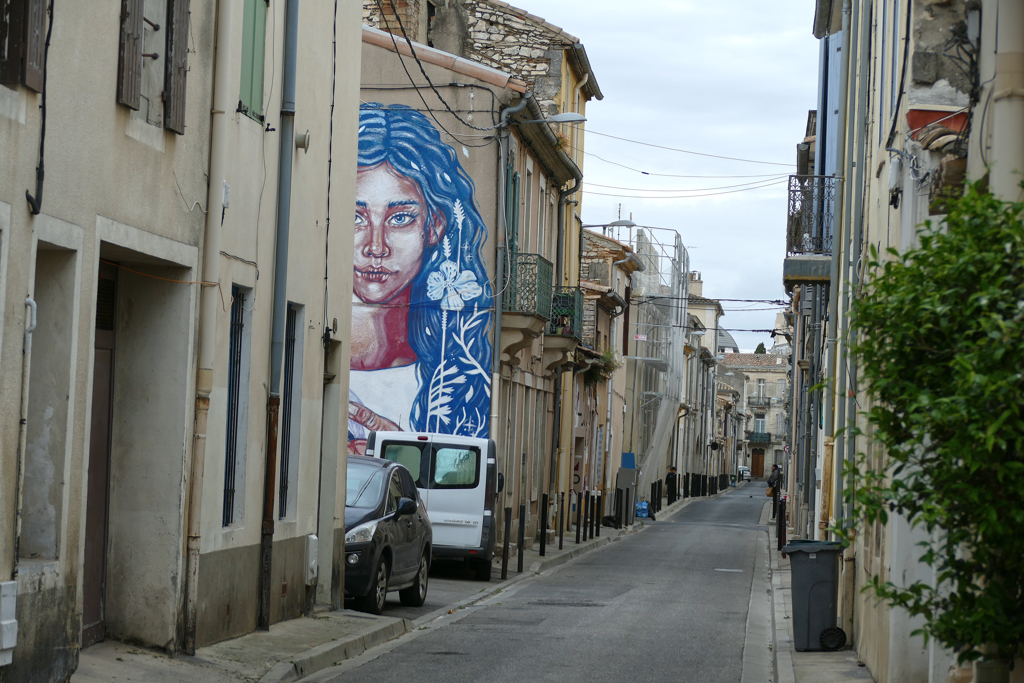
And Nîmes doesn’t just consist of historic buildings worthy of World Heritage status and the well-kept districts in the city center. There are also economically disadvantaged neighborhoods north of the center, where subcultures predominate and the color of powerful murals holds the almost dilapidated facades together.
A city has many facets to discover, and Nîmes is an excellent example of this.
In the Footsteps of the Romans
Even though it would be far too one-dimensional and you would miss a lot if you only focused on the Roman heritage of Nimes, I’ll start with that. This is logical chronologically and geographically, at least when you arrive in Nimes at the train station or bus station on the southern edge of the city center. Leave your luggage at the Ibis Styles* directly opposite the train station and head off across the long Square Feuchères towards the Amphitheater.
Nîmes Train Station
The construction of the first station in Nîmes responds to a very specific economic, industrial, political, and cultural context. At the end of the 18th century, Nîmes was one of the great manufacturing cities of France. Its production was exported throughout the Mediterranean basin and as far as India. Hence, the arrival of the railway was crucial for such an important commercial location.
Nîmes station was built to the south of the city, between 1842 and 1844, which makes it one of the oldest train stations in France. Apart from being the city’s main station, it is an emblematic monument of the 19th century and the Industrial Revolution.
Its architecture is a direct reference to the Amphitheater. The viaduct, which is the main component of the construction, runs south of the city from east to west. It is 1760 meters long and has 207 arches. The arches were used by craft businesses in the 19th century and are now often blocked off or house small businesses.
Pradier Fountain
If you stroll north from the train station via Square Feuchères and thus towards the city center, you will first come to the so-called Esplanade. It has been one of the city’s central squares since the 16th century. In the center is the monumental Pradier Fountain.

Created by architect Charles Questel and sculptor James Pradier, this monumental marble fountain was inaugurated in 1851.
In its center, a woman allegorically represents the city of Nîmes. As a crown, it bears the city’s symbolic Roman monument, namely the Maison Carrée.
It is surrounded by four seated sculptures. These two men and two women represent the region’s four major water sources: the Fontaine de Nîmes, the Gardon River, the Fontaine d’Eure, and the River Rhône.
Roman Amphitheatre
Like in Arles, Nîmes’ most important landmark is an Amphitheater. It was built during the Roman Hegemony between 90 and 120 AD, following the example of the Colosseum in Rome. The building is an impressive example of Roman engineering. It has a perfectly symmetrical oval shape and seats 24,000 spectators. A well-thought-out system of underground rooms and an elevator made it possible to transport the animals to the gladiator games effortlessly.
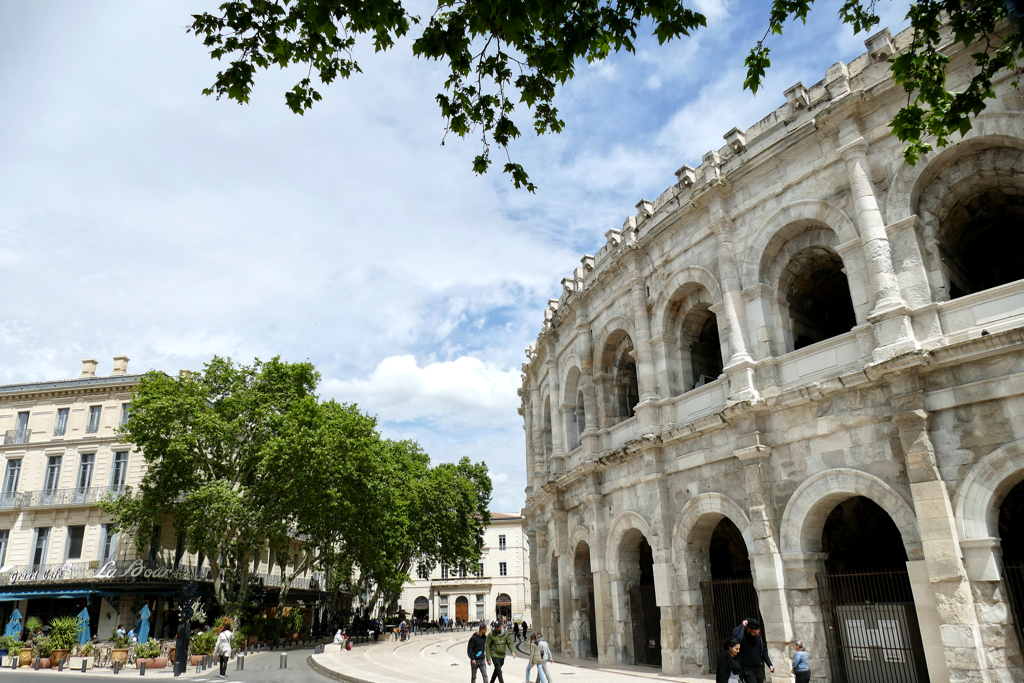
In 1863, it was converted into a bullring. Every year, around 20 traditional corridas take place. However, there are also the cruelty-free bull games Courses Camarguaises. Unlike in classic bullfighting, the animals are not injured. The Amphitheater is also the venue for cultural events such as concerts or historical plays.

A visit offers a fascinating history lesson, and climbing to the upper tiers grants fantastic views of the city. Thanks to its uninterrupted use, it is the best-preserved arena in the world.

For a general admission fee of 10 €uros, you can visit the site from 9 a.m. to 5 p.m. In April, May, and September, they are closing only at 6.30 p.m.

Musée de la Romanité
If you want to add some background information to your visit to the amphitheater, you will find the Musée de la Romanité right opposite.
It showcases the city’s collections of archaeological finds. History is miraculously brought to life by amazing audiovisual technologies.

But the building is also absolutely fascinating just from the outside. Architect Elizabeth de Portzamparc has thought the appearance through down to the last detail: The building is wrapped in a pleated toga made of glass, the slats of which are reminiscent of a mosaic.
From the roof terrace, you have a wonderful all-round view of Nîmes.
The museum is open every day from 10 a.m. to 7 p.m., and the general entrance fee is 9 €uros.
Maison Carrée
The Maison Carrée is a rectangular Roman temple completed in Nîmes in the 2nd century AD, not long after the city was founded by Emperor Augustus.
And it was dedicated to this very Augustus to the glory of his two grandsons, consuls, and military leaders Lucius Caesar and Caius Julius Caesar. The temple stood south of the Forum, which covered a vast area in the heart of the Roman city of Nemausus.

Over the centuries, the temple was used as a town hall, a church, and then a museum of ancient art. Due to its continuous use, it is now the best-preserved Roman temple in the world.
Inside, a new information center tells the story of the monument in a historical context. Visitors learn a lot about Roman architecture, the imperial cult, and the importance of the ornamentation of the Maison Carrée.
Every half hour, an informative film introduces the early history and basics of the city.
The Maison Carrée is open every day from 9.30 a.m. to 6.30 p.m., and the general entrance fee is 6 €uros.
Carré d’Art
The Carré d’Art is a cultural center that houses contemporary art and the city library, modeled on the Center National d’Art et de Culture Georges-Pompidou in Paris. The building was designed by British architect Sir Norman Foster and is located on the old forum opposite the Maison Carrée. Although Foster used glass, concrete, and steel for his design, he managed to pay conceptually and artistically tribute to the Maison Carrée, hence, taking up its shape and style.
The Carré d’Art opened in May 1993.

While the ongoing exhibitions didn’t really convince me, my time enjoying a strong coffee and a sweet Nutella Crêpe was not only a refreshing break. Most importantly, it offered me a breathtaking view of the Maison Carrée at my feet as well as of large parts of the city and beyond. The best thing, however, is that you can simply skip the exhibitions and take the elevator directly to the 6th floor, where the café with a beautiful covered terrace is located.
The Carré d’Art opens every day at 10 a.m. and closes between 6 p.m. and 7 p.m., depending on the day of the week. Access to the building is free of charge, yet, you have to pay an entrance fee of 8 €uros if you want to visit the temporary exhibitions as well as the permanent collection. These are free the first Sunday of the month.
Jardins de la Fontaine
The Jardins de la Fontaine district emerged in the Gallo-Roman period and is one of the oldest parts of the city. The gardens were constructed around the original Nîmes spring in 1745. This headwater was already revered by peoples prior to the arrival of the Romans.
The gardens were the first public park in France and one of the first in all of Europe. The hilly area is crisscrossed by canals and enriched by magnificent fountains and beautiful statues.
As you climb to the highest point of Nîmes, you will get to the Magne Tower. It dates from the 3rd century BC, which makes it one of the oldest structures in Europe. There is much speculation about the tower’s original purpose. In Roman times, it was part of the city wall and was certainly used for protection. It was probably also utilized to transmit messages.
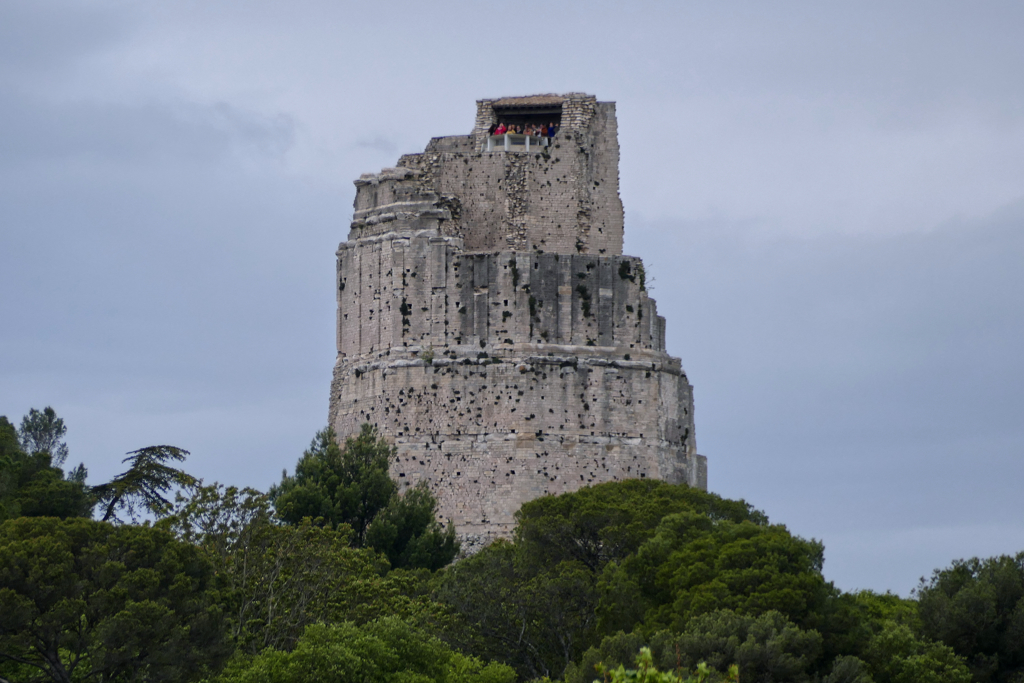
Another ancient building was the Roman cult site called Augusteum, of which only the Temple of Diana remains today. Here, too, its primary function is debated. In the Middle Ages, it housed a monastery, which explains its relatively good state.
The gardens are open every day from 7.30 a.m. to 6.30 p.m. An entrance fee of 3.50 €uros only applies if you want to climb the Tour Magne.
Place Gabriel Péri
West of the Place Gabriel Péri stands the so-called Augustus Gate. It is a Roman monument from the 1st century BC.

After its construction, it was part of the long Roman wall of Nîmes and one of the main gates of the city. It consists of two large arches for vehicles, which are flanked by smaller arcs for pedestrians. However, today, only remnants remain at the northeastern end of the old city center.
It comes as no surprise that the good man you’ll spot behind the portico is none other than Augustus, the first Roman emperor and namesake of the gate. Obviously, this larger-than-life sculpture called Augustus of Primaporta is only a copy of the original that you get to admire at the Musei Vaticani in Rome.

The gate used to be flanked by two semicircular towers. Today, the exact location of these towers is marked on the sidewalk by circles of large flat stones.

In the center of the Place Gabriel Péri stands the neo-Gothic Église Saint-Baudile de Nîmes. It was completed in 1877 according to plans by architect Jean-Jules Mondet from Bordeaux and dedicated to Saint Baudile, a 3rd-century martyr from Nîmes.
Museum of Fine Arts
The Musée des Beaux-Arts was founded in 1821 in the Maison Carrée and initially housed works of Roman antiquity as well as some paintings. When the space became too small, it moved to its current home in 1907. The collection has been assembled since 1824 and supplemented by private collections.

I am a huge art aficionado. Nevertheless, I would argue that a visit to the galleries is only worth it when it is pouring rain or if you want to see a specific exhibit. Whereby I’m wondering what that could be.
Anyway, if you want to see why I’m underwhelmed, you can check the museum out from Tuesday to Sunday between 10 a.m. and 6 p.m. for 5 €uros.
Urban Art
Boulevard Gambetta runs north of the proper city center like a social demarcation line. On the other side of the road, the houses are a little more dilapidated, the cafés are a little less elegant, and many residents look a little more tired.

The districts of Gambetta and Richelieu are close to the center and yet worlds apart. Their world is characterized by workers, craftsmen, and immigrants from France’s former colonies.
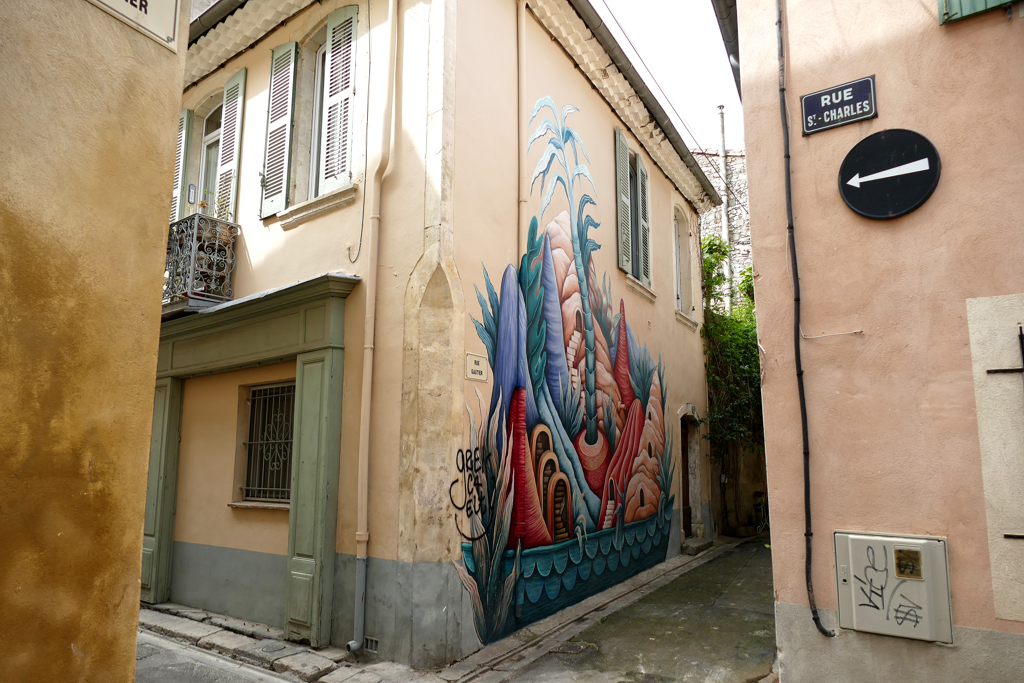
As I mentioned above, the initial spark of my visit to Nîmes was urban art, and these districts are a true treasure chest when it comes to powerful murals. Although I had a list of the most important works I wanted to see, I quickly gave up on following a structured itinerary and simply got lost between run-down buildings, narrow alleys, and unexpected amounts of amazing graffiti.

Although my main focus was on urban art, this post is intended to be a comprehensive guide to various sides of Nîmes. Therefore, urban art remains just one of many aspects. However, you can delve deeper into the topic in my post Best Street Art in Nîmes. There you’ll find out more about the development of Nîmes’ urban art as well as introductions to many artists and their works.
Practical Information
How to Get There
By Plane
Nîmes-Garons Airport is located around 20 kilometers South of the city center. But please don’t expect flights to every corner of the world every half hour. Truth be told, there aren’t even that many domestic flights. However, a shuttle bus runs between the airport and the city center. It costs 6.80 €uros one way and the trip takes about 15 minutes.
Alternatively, you can get to Nîmes by plane via Marseille-Provence Airport. It is located about 100 kilometers southeast. From there, you can continue your trip to Nîmes either by Flixbus or by regional train via Arles. Depending on your connection, the trip takes one to two hours.
By Train
The SNCF connects Nîmes to Montpellier and Avignon by the regional train called TER, and Paris, Lyon, and even cities in Spain by TGV. Also, going from London to Lille by Eurostar and then by TGV to Nîmes is easily done in a day.
You can get information and book tickets online on the website of the national train company SNCF.
Obviously, you can also buy your ticket at the station right before departure. However, I would only recommend this for short distances and travel on regional trains. Travelling by public transportation is very popular in France, so trains tend to be either very full or, when a reservation is compulsory, even sold out.
Buying a ticket from a machine for the first time can be quite an adventure, especially if you’re a first-timer. That’s why I’m explaining the necessary steps in my post France – An Easy Circle Trip to the Five Best Cities to Visit in Provence, and I really urge you to check it out. You’ll see, buying a ticket is actually not that complicated – once you know how to do it.
By Bus
As in all the cities I visited during my trip through Provence, the bus terminal in Nîmes, Gare Routière in French, is right next to the train station. Various bus companies offer trips between Nîmes and many cities in France as well as other European countries.
The two most popular are probably Eurolines and FlixBus. They don’t just go to Bordeaux, Marseille, and Paris. You can even reach Barcelona in 6 to 8 hours, Milan in 10 to 13 hours, and Prague in 23 hours with a connection via Lyon.
However, you will be surprised that a bus journey can be faster than the train, especially on short distances, for instance to Marseille; cheaper anyway.
How to Get Around
The city center of Nîmes is actually not that big. All the landmarks listed in this post can be easily reached by walking. However, as you’ll still walk a lot and the ancient Roman structures are not that easily climbed, make sure to wear sensible shoes, preferably sneakers.

Nîmes’ system of public transport consists of regular buses and so-called tram-buses. Tickets are pretty cheap: For 1.60 €uros, you can travel for one hour as much as you please! There are also passes for two to ten rides, which makes every trip a little cheaper. For instance, the ten-trip pass costs 12.30 €uros. Finally, there is a day pass for 4 €uros.
To check your route and connections, just use Google Maps. The App even informs you when the bus is late. However, on weekdays, buses go every ten to twenty minutes. On weekends, there are fewer connections, obviously.
Also, renting a city bike is a valid option. véloTANGO is the city’s official bike rental company and is located at the main train station. They charge 3 €uros if you rent a regular bike and 7.50 €uros for E-bikes.
Where to Stay
One of the great advantages of French centralism is that those totally preposterous prices also stay in the capital. As soon as you leave Paris, things get significantly cheaper, which also applies to accommodation.
Especially when you are in Nîmes only for one or two days, you might want to stay in a centrally located hotel so you can explore all the wonders the city has to offer by walking.
I came to Nîmes by train from Arles, hence, I was more than happy to have stayed at the Ibis Styles* just across the street from the main train station.
In case they are booked out or if you simply prefer a different kind of accommodation, you can choose suitable lodging options in Nîmes on this map*:
What to Eat
French cuisine is famous all over the world for a reason. In fact, food is an important part of daily life in France, and regional cuisines and customs are a cherished part of the national culture. UNESCO recognized France’s efforts and designated the country’s national cuisine as an intangible cultural heritage in 2010.

French cuisine is famous for its sophistication and versatility, and, most importantly, the high quality of the ingredients used. Of course, each region has its own specialties, but they are often popular throughout the country. The most famous dishes come from Normandy, Brittany, Burgundy, and the Provence region, obviously.
The Best Snacks
Unfortunately, food in France is not cheap. In general, lunch menus and daily specials, so-called plat du jour, are comparatively affordably priced. Delicious snacks at reasonable prices are available in bakeries and rotisseries as well as in Nîmes’ covered market hall.
Do you want to know what to try here? Hmm, how about brandade, a kind of cod gratin? And if you want to enjoy it as a quick snack, then take it as a pastry covered in delicate puff pastry. A delicacy!
I admit that I am a huge carb friend. I particularly fancy savory pastries. For people like me, Nîmes has the right cure: Pâté Nîmois. It is a thick puff pastry with a generous heart of veal and pork.
By the way, my evergreen among French snacks remains Quiche Lorraine, a tart with a filling made of cream, eggs, and bacon.
If you’re looking for an edible souvenir, try Croquants Villaret, almond cookies very similar to very hard Amarettini.
But definitely don’t get the idea of carrying soft cheese in your hand luggage! Creamy cheese is considered a liquid. For TSA agents, it basically equals shampoo.
Do not believe me?
Been there, done that: You can read about my adventure at Toulouse airport in my post Cheesy Flight: Never Put Cream Cheese In Your Hand Luggage.
A final tip: If your accommodation offers breakfast at a halfway reasonable price, take it. Albeit, you can always grab a croissant and a café au lait at a bakery. However, since you can drink as much coffee and eat salty and sweet pastries as you like, you will probably get a better deal at the hotel as long as the price doesn’t exceed let’s say 12 €uros.
Cash, Cards, and Deals
Since 2001, 20 European countries have been paying with €uros, and France is, obviously, one of them. The exchange rate is 1 US$ = 0,85 EUR as of June 2025, but you can check the conversion on this page.
Also, you can pay with credit cards basically everywhere.
Although Nîmes is not the country’s most expensive city, if you want to visit some of the amazing landmarks and museums, it quickly adds up.
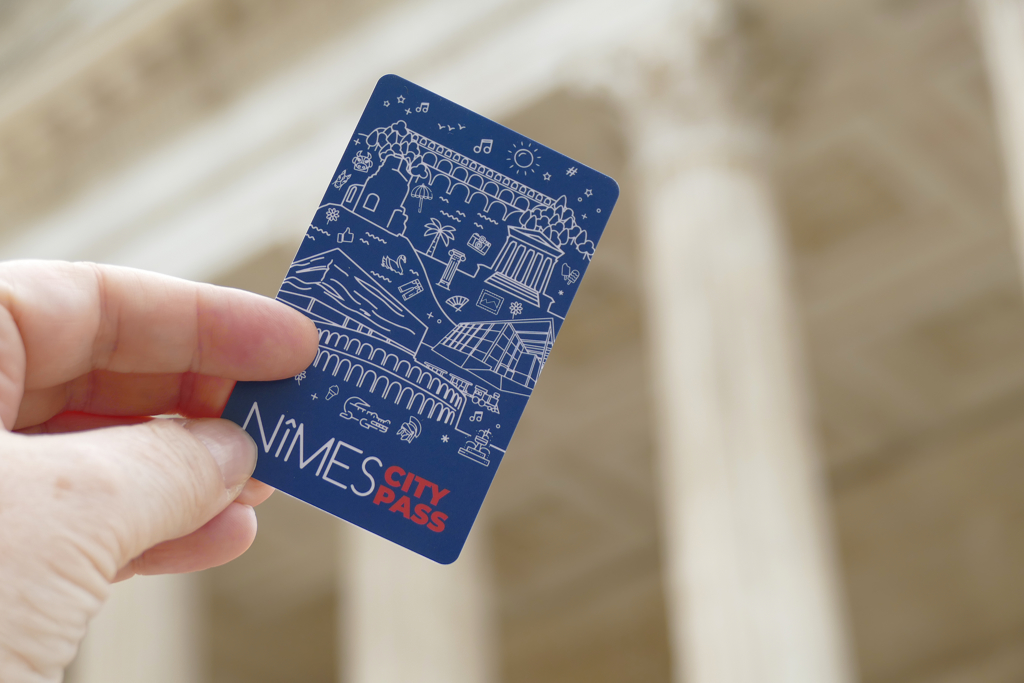
You can save quite a bit of money with the Nîmes City Pass*, as it grants you free entry to the city’s main attractions and museums. If your knowledge of French allows it, you can also take part in city tours.
| 2 Days | 4 Days | 7 Days | |
| 29 €uros | 37 €uros | 39 €uros |
Visiting Organized
Although I’m an avid solo-travelling woman, I sometimes like to join organized tours. This way, I get extended info about a place and it’s fun to visit landmarks in the company of like-minded fellow travellers.
Especially in summer, when the lavender is in full bloom in the Provence region, popular places such as Nîmes can get quite busy. Therefore, booking tickets’n’tour ahead is certainly a good idea**:
Connection and Communication
Since June 2017, no roaming charges have applied within the EU with a European mobile phone contract. This applies in all 27 countries of the European Union, as well as in Iceland, Liechtenstein, and Norway, and to all contracts.
In case European roaming is unavailable, you can connect to the internet without any issue at basically every museum, eatery, café, and, of course, hotel.
If you insist on being online 24/7, you can get a SIM card, obviously. There are prepaid SIM cards from many companies. At 2.99 €uros, Orange France distributes the cheapest one. Other brands are SFR France, Bouygues Telecom, and Free Mobile. They cost 10 €uros. Keep in mind that some companies might also charge an activation fee.
In France, they use plug types C and E. Their voltage is 230 V and the frequency is 50 Hz. Whereby, as nowadays, all these chargers have integrated adapters, in general, the voltage and frequency don’t really matter.
By the way, you’ll find this information and many more comprehensive travel tips in my post World’s Most Complete Travel Information – an indispensable globetrotter classic.
Language
The French are famous for many great things. Presumably, speaking foreign languages is not one of those. While in über-touristy Paris, things seem to get a bit better, in the Provence region, people have rudimentary knowledge of English at most.

And while they still might understand more or less what you are saying, they might not be able or willing to answer in English. Therefore, already out of respect, it won’t hurt to learn at least some polite phrases with the help of babbel or Lingohut, for example.
Map
This map should help you to find all the wonderful places I’m introducing in this post. Clicking on the slider symbol at the top left or the full-screen icon at the top right will display the whole map, including the legend.:
Nîmes was only one of five amazing cities I visited during my circle trip through Provence. To read about the others, go to the post France – An Easy Circle Trip to the Five Best Cities to Visit in Provence and take your pick! There, you’ll also find further valuable general information that will make your own trip much smoother and more enjoyable.
Pinnable Pictures
If you choose to pin this post for later, please use one of these pictures:






Note: I’ve thoroughly completed, edited, and updated this post in June 2025.
Did You Enjoy This Post? Then You Might Also Like These:
Best Places to Visit in Basse Terre, the Western Wing of GUADELOUPE (also by public bus)
BORDEAUX: Best Street Art on the Right Bank of the Garonne
The Best Beaches in Guadeloupe You Can Easily Visit by Public Bus
The Best Beaches in Martinique You Can Easily Visit by Public Bus
Best Street Art in PARIS: How Mehdi Ben Cheikh Transformed the 13th Arrondissement Into An Open-Air Gallery
What Not to Miss in PARIS: 20 Must-Dos, Not Only for First-Timers
Best Street Art in GUADELOUPE
BORDEAUX: Best Street Art on the Left Bank of the Garonne
Disclaimer: I am very appreciative that Office du Tourisme de Nîmes supplied me with a complimentary Nîmes City Pass. Nevertheless, the description of these activities and all opinions on their services are mine and were in no way influenced by my cooperation partner.
* This is an affiliate link. Hence, If you book through this page, not only do you get the best deal. I also get a small commission that helps me run this blog. Thank you so much for supporting me!







